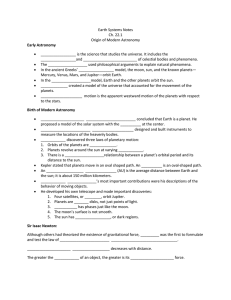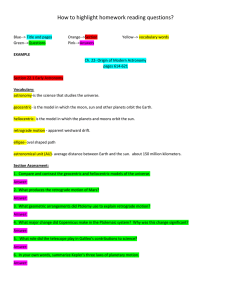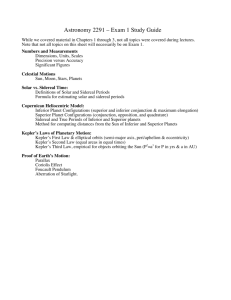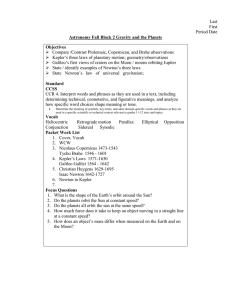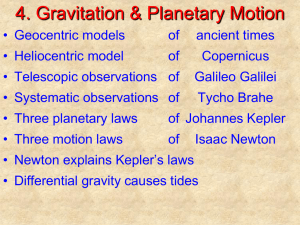pptx
advertisement
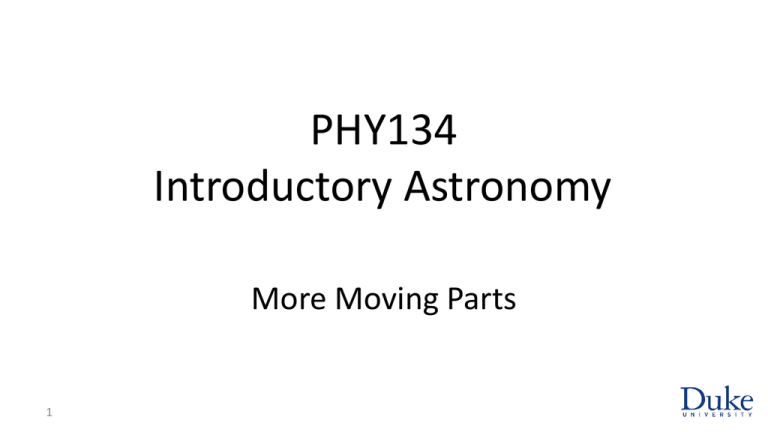
PHY134 Introductory Astronomy More Moving Parts 1 Signs of the Times • Astronomy and timekeeping are always closely related – we want our time to match what happens. • Our 24-hour days are adjusted to mean solar day. • Our months are approximately lunar. • Our years match orbit – 365.2564 days is a sidereal orbit. • Tropical orbit is 365.2422 days (precession). • Julius Caesar got 365.25 so invented leap years. • Pope Gregory XIII (1582) corrected for the .0078 2 So Far • Our cosmos now has moving parts – Sun moves around Celestial Sphere to the East, completes one revolution in a year. The ecliptic tilted relative to celestial equator by 23.5° about equinoxes and precesses West every 26,000 years – Moon moves around Celestial Sphere to the East, completes one revolution in a month. Moon’s orbit tilted relative to ecliptic by 5° about line of nodes and precesses West every 18.6 years • The model now explains day/night, lunar phases, eclipses • What else moves? 3 Wanderers • Five wandering stars (planets) also move along paths very near the ecliptic • Rates of motion vary among planets, so each located on its own sphere. We now have seven spheres • Planetary motion less regular than Sun or Moon. Rate changes and sometimes turns retrograde 4 Ptolemaic Astronomy • Hipparchus (150BC): Planets move on epicycles which move along deferents • Ptolemy (150AD) elaborates model to account for small deviations • Ptolemaic model predicts planetary motions accurately – successful scientific model • Ptolemaic order of spheres: Moon, Mercury, Venus, Sun, Mars, Jupiter, Saturn; Fixed Stars 5 How it works • Venus never too far from Sun • Its deferent circles about once a year • Epicycle rotation accounts for periodic change in elongation • When West/East of Sun we see morning/evening star 6 Antihythera • 1901 pearl fishers find sunk ship from 80BC • Many bronze artifacts including astronomical calculator • Predicts positions of planets, moon phases, eclipses using Ptolemaic model 7 An Alternate Model • Heliocentric model (Aristarchus 270BC): planets – and Earth - orbit the Sun • Perceived motion of planets results from relative motion of planet and Earth • Retrograde motion explained simply • Copernicus (1543) produces a detailed heliocentric model competitive with Ptolemy 8 Periods • Planet orbits Sun in time P – sidereal period • Earth orbits Sun in time E - sidereal year • Planet’s synodic period S is time between conjunctions/oppositions for inferior/superior planets • Can relate them mathematically 9 Computing Periods 10 So Which is it? • Both models produce predictions matching observations of apparent motion • Culturally difference is huge: does Earth move? Is it central? • Scientifically difference is in motion of planets in 3d. • Other things change in the heavens: Comets come and go and their motion does not fit well with either model • Real determination: better observations with new technology • Leads to new understanding of fundamental laws that are universal. That is the scientific revolution 11 Data Gathering • Tycho Brahe (1580) makes observations of planetary motion with improved accuracy • J. Kepler (1609) finds that these are consistent with heliocentric model governed by three laws 12 Kepler’s Laws • 1. Orbit of a planet is an ellipse with Sun at one focus • What’s at other focus? Nothing, not even the same for all planets • Eccentricity small: 0.017 for Earth, 0.2 for Mercury. 13 • 2. Line from Sun to planet sweeps out equal areas in equal times • Planet moves faster near perihelion, slower near aphelion • Comets in highly eccentric orbits – dramatic effect Kepler’s Third • 3. Square of sidereal period proportional to cube of semimajor axis Same 14 for all planets! Galileo’s Smoking Scope • New technology: Galileo (1610) turns telescope up • Finds – phases of Venus showing it orbits Sun – Galilean moons orbiting Jupiter – Mountains on Moon, spots on Sun, ears on Saturn 15 • Also studied mechanics (science of motion) and formulated principle of inertia: An object will retain its state of motion unless disturbed externally • To really get mechanics, Newton had to invent calculus This is Progress • Galileo studies heavens as a physical system to be observed • Kepler’s laws predict planetary motion with unprecedented accuracy from simple model • They are universal. In fact, they govern orbiting systems from Solar System to Saturn’s Moons to…electrons in an Atom (with different K) • Such universality is a hint of underlying fundamental laws • It took Newton and new math to find them 16



